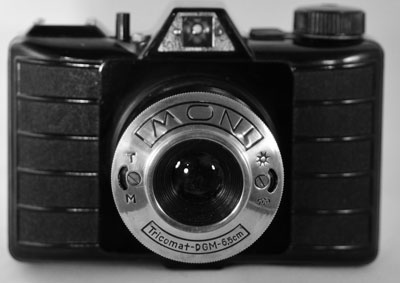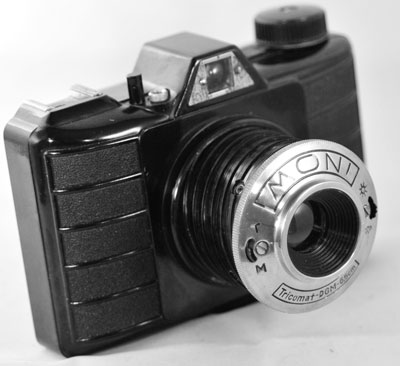Hamaphot Moni
Specification


| Manufacturer | : | Hamaphot |
|---|---|---|
| Produced | : | 1953 |
| Classification | : | Medium Format |
| Body Type | : | Extending Helix |
| Construction | : | Bakelite Plastic |
| Film Type | : | 120 |
| Film Width | : | 62mm |
| ImageSize | : | 2¼ x 2¼ |
| No. of Images | : | 12 |
| Lens Type | : | Tricomat-DGM |
| Focus Type | : | Fixed |
| Focal Length | : | 65mm |
| Focal Range | : | 2.75m - inf. |
| Aperture Type | : | Multihole |
| Aperture | : | f/8, f/16 |
| Shutter Type | : | Rotary |
| Shutter Speeds | : | T, I*(1/50 s) |
| Size Open (w x h x d) | : | 125 x 85 x 85 mm |
| Size Closed (w x h x d) | : | 125 x 85 x 55 mm |
| Weight | : | 201g |
| * Measured on this camera | ||
Art Deco Credentials
![]()
![]()
![]()
Noteworthy: Worth giving special attention
- Designed after the main Art Deco period.
- Curvilinear body design in Streamline Moderne style
- Leather pattern in Bakelite
- Horizontal ribbing to plastic body
- Trapesium shaped viewfinder moulding
- Chrome lens plate
- Black lettering
Description
Manufactured under licence from Pouva. Very similar to the Pouva Start.
The camera is fairly simple. It takes 12 6cm x 6cm pictures on 120 roll film. On the top is the shutter release button. There is also a cable release socket. Also on the top is an reverse galilean viewfinder optical viewfinder and the film advance wheel. There is a lever on the top for prizing the back off the camera. On the bottom is the tripod mount. On the back is the red exposure counting window.
On the lens barrel's front plate there is a switch for choosing Instant[M](1/50s) or Bulb[T] function. The aperture is changed by a switch which is annotated with  (f/8) and
(f/8) and  (f/16). The lens is a Duplar having two lenses, one in front and one behind the aperture and shutter.
(f/16). The lens is a Duplar having two lenses, one in front and one behind the aperture and shutter.
The camera's most characteristic feature is that the lens is deployed by turning the barrel counter-clockwise by 360 degrees. The helical screw moves the lens outward into the working position. It is not possible to fire the shutter until the lens is completely deployed. When the lens is deployed, a PC sync socket for flash is revealed on the helicoid, close to the lens plate. There is a recessed accessory shoe on the top.
How to Use
This camera takes 120 film which easily available from most photographic outlets. Don't forget to cover the red window with black electrical tape except when advancing the film in low light. Modern film is sensitive to red light.
Shutter speeds is 1/50s. The aperture values available are  f/8,
f/8,  f/16.
f/16.
If you don't want to bother with an exposure meter, follow the guide shown. It is based on the 'Sunny 16' rule. Film is so forgiving and will produce acceptable results even when overexposed by 2 or 3 stops or underexposed by 1 stop.
Remember that the exposure guide in the camera user manual may not be helpful as it is based on the use of old film with a low ISO value.
The tables assume that the sun is at least 30 degrees above the horizon - that's 10am - 5pm on a summer's day (May-August) in the UK.
Because of the slow speed of this camera, you may need a tripod or hold the camera firmly against your face to stop blur through shake.
Using ISO 100/125 film - shutter speed 1/50s
| Weather Conditions | Shadow Detail | Aperture | Exposure |
|---|---|---|---|
 Sunny SunnySnow/Sand | Dark with sharp edges |  f/16 f/16 | +2 Stops Overexposed Acceptable |
 Sunny Sunny | Distinct |  f/16 f/16 | +1 Stops Overexposed Acceptable |
 Slight Overcast Slight Overcast | Soft around edges |  f/16 f/16 | Good |
 Overcast Overcast | Barely visible |  f/8 f/8 | +1 Stop Overexposed Acceptable |
 Heavy Overcast Heavy Overcast | None |  f/8 f/8 | Good |
 Open Shade Open Shade/Sunset | None |  f/8 f/8 | -1 Stop Underexposed Acceptable |